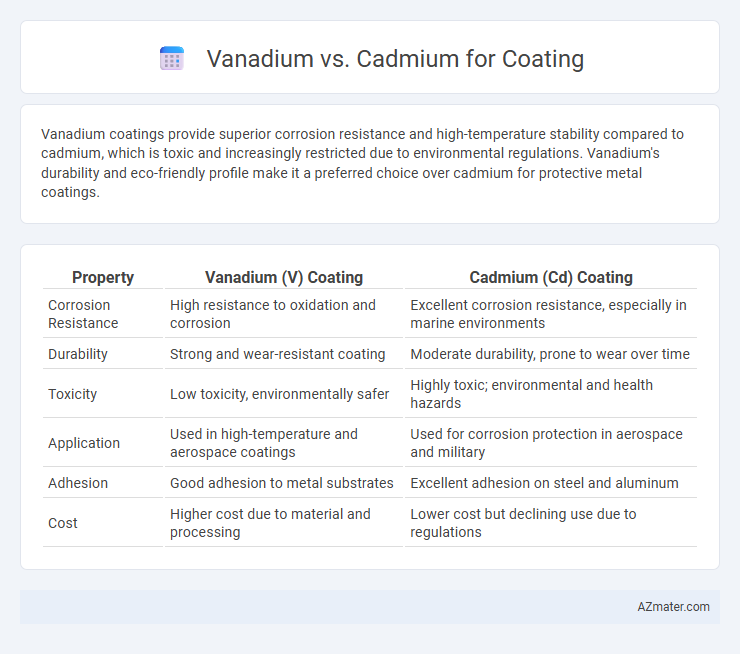Vanadium coatings provide superior corrosion resistance and high-temperature stability compared to cadmium, which is toxic and increasingly restricted due to environmental regulations. Vanadium's durability and eco-friendly profile make it a preferred choice over cadmium for protective metal coatings.
Table of Comparison
| Property | Vanadium (V) Coating | Cadmium (Cd) Coating |
|---|---|---|
| Corrosion Resistance | High resistance to oxidation and corrosion | Excellent corrosion resistance, especially in marine environments |
| Durability | Strong and wear-resistant coating | Moderate durability, prone to wear over time |
| Toxicity | Low toxicity, environmentally safer | Highly toxic; environmental and health hazards |
| Application | Used in high-temperature and aerospace coatings | Used for corrosion protection in aerospace and military |
| Adhesion | Good adhesion to metal substrates | Excellent adhesion on steel and aluminum |
| Cost | Higher cost due to material and processing | Lower cost but declining use due to regulations |
Introduction to Metal Coatings
Vanadium and cadmium serve distinct roles in metal coatings, with vanadium known for enhancing hardness and wear resistance through its incorporation in alloys and surface treatments. Cadmium coatings provide excellent corrosion resistance and sacrificial protection, especially in aerospace and marine applications, due to their ability to prevent rust formation. Choosing between vanadium and cadmium depends on specific performance requirements, environmental considerations, and regulatory restrictions associated with cadmium usage.
Overview of Vanadium and Cadmium as Coating Materials
Vanadium and Cadmium are widely used as coating materials due to their corrosion resistance and mechanical properties. Vanadium coatings provide excellent surface hardness and oxidation resistance, making them ideal for high-temperature and wear-resistant applications. Cadmium coatings offer superior corrosion protection, especially in marine and aerospace industries, due to their sacrificial anode characteristics and ability to prevent galvanic corrosion.
Chemical Properties: Vanadium vs Cadmium
Vanadium exhibits excellent corrosion resistance due to its stable oxide layer, making it ideal for protective coatings in aggressive environments, whereas cadmium offers superior cathodic protection by acting as a sacrificial anode. Chemically, vanadium's multiple oxidation states (from +2 to +5) allow versatile coating applications, while cadmium's consistent +2 oxidation state provides predictable electrochemical behavior. Vanadium coatings are less toxic and environmentally friendlier compared to cadmium, which is known for its toxicity and regulatory restrictions in industrial use.
Corrosion Resistance Comparison
Vanadium coatings exhibit superior corrosion resistance compared to cadmium, especially in aggressive environments such as marine or industrial atmospheres. Vanadium forms a dense, stable oxide layer that effectively protects underlying metals from oxidation and corrosion, enhancing durability and lifespan. In contrast, cadmium coatings provide moderate corrosion protection but suffer from environmental and health concerns, leading to decreased usage in favor of more sustainable alternatives like vanadium.
Environmental Impact and Safety
Vanadium coatings offer a lower environmental impact compared to cadmium, primarily due to vanadium's reduced toxicity and greater abundance, which decreases the risk of harmful environmental contamination. Cadmium is a known carcinogen and poses significant health hazards to workers during application and disposal, necessitating strict regulatory controls. Vanadium-based coatings provide safer alternatives in industrial applications by minimizing hazardous emissions and promoting sustainability.
Mechanical Strength and Durability
Vanadium coatings exhibit superior mechanical strength and durability compared to cadmium, providing enhanced wear resistance and better performance under high-stress environments. Vanadium forms a hard, corrosion-resistant layer that maintains structural integrity over extended periods, reducing maintenance costs and downtime. Cadmium, while offering moderate corrosion protection, generally lacks the same level of mechanical robustness and suffers from environmental and health concerns limiting its use.
Cost Efficiency Analysis
Vanadium coatings offer superior cost efficiency compared to cadmium due to lower raw material costs and enhanced durability, reducing long-term maintenance expenses. Cadmium's toxicity and environmental regulations increase disposal and handling costs, making vanadium a more economical choice for sustainable industrial applications. Industry data indicates vanadium's extended lifespan and corrosion resistance contribute to significant savings in total ownership costs over cadmium coatings.
Industrial and Commercial Applications
Vanadium coatings offer superior corrosion resistance and enhanced hardness, making them ideal for industrial applications such as automotive parts and heavy machinery components. Cadmium coatings provide excellent protection against galvanic corrosion, commonly used in aerospace and marine industries where electrical conductivity and rust prevention are critical. Industrial sectors often prefer vanadium for high-temperature environments, while cadmium remains valuable for its unique electroplating properties despite environmental restrictions.
Regulatory Compliance and Restrictions
Vanadium coatings face fewer regulatory restrictions compared to cadmium, which is heavily regulated due to its toxicity and environmental impact under frameworks such as REACH and RoHS. Cadmium usage is limited or banned in many industries, especially in aerospace and electronics, due to strict exposure limits established by OSHA and EPA. Vanadium offers a safer alternative for corrosion resistance and hardness in coatings, aligning more easily with global compliance standards.
Future Trends in Coating Technologies
Vanadium coatings are gaining traction due to their superior hardness, corrosion resistance, and eco-friendly profile compared to cadmium, which faces regulatory restrictions because of toxicity concerns. Emerging trends highlight the increasing adoption of vanadium-based nanocoatings and thin films for aerospace and automotive industries, driven by demand for lightweight and durable materials. Advances in atomic layer deposition and pulse electroplating further enhance vanadium coating uniformity and performance, positioning it as a sustainable alternative to cadmium in future surface engineering applications.

Infographic: Vanadium vs Cadmium for Coating
 azmater.com
azmater.com